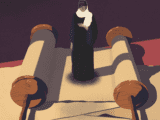Earlier this month in Linz, Austria, vandals beheaded a controversial sculpture of the Virgin Mary. The piece was part of a modern art installation in St. Mary’s Cathedral, the country’s largest church, that sought to turn the space into “a venue for discussion of contemporary questions about women’s roles, family images and gender equality.”
Working along those themes, artist Esther Strauss created a sculpture of the Virgin Mary in the act of giving birth, her haloed head thrown back in anguish, her signature robes hiked up to her chest and her belly and legs bare. The work is titled Crowning, a play on words: her son, once born, will be crowned the King of Kings. The term also refers to when the baby’s head becomes visible in the vaginal opening.
This is, of course, in opposition to how the Virgin Mary is typically portrayed. Though her central act in the Gospels is to give birth to the son of God, she’s rarely depicted doing so in art. Instead, she’s shown fully clothed and heavily pregnant, demurely sitting on a donkey while she and Joseph search for a place to stay. Or else she’s crouching over Jesus in the manger, fully clothed once more and surrounded by curious animals. What happens in between is typically censored, and certainly there is no depiction or discussion of the anatomical parts involved, beyond vaguely euphemistic references to Mary’s womb.
Want more on Mary? Listen to the episode of our podcast, “And Also Some Women,” that dives into her fascinating story.
While Strauss’s sculpture is nontraditional, its presence in the installation was officially sanctioned by the Catholic Church — much to the dismay of the anonymous vandals, who described it as an “abominable and blasphemous caricature” in a statement read by Alexander Tschugguel, an ultra-conservative Austrian Catholic best known for stealing several Amazonian Indigenous statues displayed at a church near Vatican City and throwing them in the Tiber River.
More on Broadview:
- Why some experts see the Virgin Mary as a prophet too
- Diana Butler Bass’s viral sermon changed the way thousands think about Mary Magdalene
- ‘Dayspring’ reimagines the Christ story through a queer, pop-culture lens
But is the sculpture really blasphemous? It might be shockingly explicit, but it doesn’t depict anything out of line with Christian dogma. Jesus chose to come to earth as a human, with all the messiness that entails. He chose to be born like a common man and die like one, too. Images of his crucifixion don’t shy away from showing all the gory details. Why, then, should his birth be so sanitized?
The issue lies in the fact that Mary is a woman, one that historian Marina Warner characterizes in her work Alone of All Her Sex as “the Church’s female paragon.” But, writes Warner, the Catholic Church has long struggled with how it views women, oscillating between “regarding them as equal in God’s eyes (endowed with an immortal soul) and yet subject and inferior to the male in the order of creation and society (“And thy desire shall be to thy husband, and he shall rule over thee” – Genesis 3:16).” This back and forth, according to Warner, “provides a continual background interference to any discussion of the Virgin, the model of the sex, who accurately reflects this perennial ambivalence.”
What seems to rankle Tschugguel and the vandals the most is that Crowning reclaims Mary from images that represent her as meek and cringing. In Strauss’s work, Mary is strong and capable — she’s giving birth in a stable without a midwife at her side. It’s an image that might be relatable, even empowering, to anyone who has given birth, and the last thing that Tschugguel and those like him want to see.
They would prefer for Mary to be depicted as an unattainable ideal, one who gives women a sense of what Warner describes as “hopeless yearning and inferiority.” How else will they make sure that women don’t step out of line?
***
Anne Thériault is a journalist in Kingston, Ont.
















Although I agree, most artist renditions of Mary is pretty weak. But we also have a lot of artist renditions of Jesus being just as weak or “meek” (not in the true definition of meek). So I don’t feel this is a valid argument.
In my opinion, Mary was pretty strong to go through the pregnancy with all the gossip of who the father was or might be.
But there is also a line of modesty. To depict Mary in the manner above is a little risqué for Christians I would think. (Would we like to see this in real life? Then why do we want to see someone’s viewpoint of the matter?)
I certainly do oppose people destroying things that do not belong to them, and I find the art distasteful But I can see why a Catholic would find it an “abominable and blasphemous caricature”. (After all, Mary is above God in their theology.)
It is the height of irony that the movie The Passion devotes nearly two hours of gore detail to the slaughter of a divine human none of which comports with scripture, just a line or two at best. But, when a woman as mothers of all living gives birth to the son of man depicted in sculpture, at best worthy of a few minute glance is awarded a decapitation in the name of “abominable and blasphemous caricature”…such astounding ignorance of what constitutes reality echoes for those consumed in self-hate, “Forgive them for they know not what they do.”
Yup. Folks do take religious mythology seriously. Isn’t it better to actually try and live one’s life the way Jesus taught?